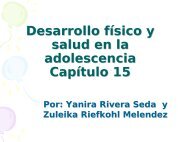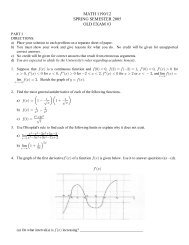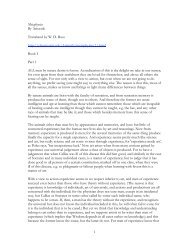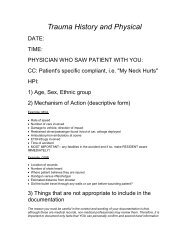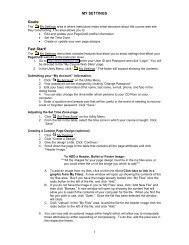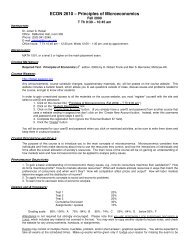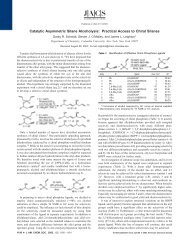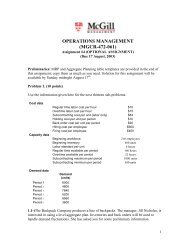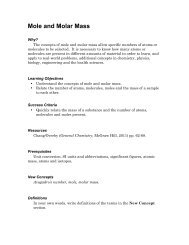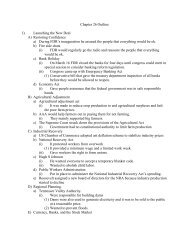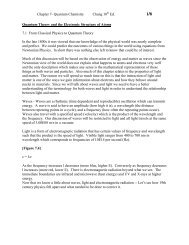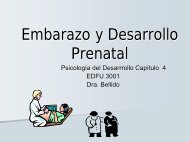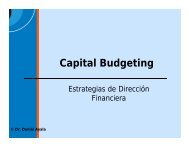Comm 725 Fall 2012 Assignment 1 (Ch. 1, 3, 10, 14) Alex ... - PageOut
Comm 725 Fall 2012 Assignment 1 (Ch. 1, 3, 10, 14) Alex ... - PageOut
Comm 725 Fall 2012 Assignment 1 (Ch. 1, 3, 10, 14) Alex ... - PageOut
You also want an ePaper? Increase the reach of your titles
YUMPU automatically turns print PDFs into web optimized ePapers that Google loves.
<strong>Comm</strong> <strong>725</strong> <strong>Fall</strong> <strong>2012</strong><strong>Alex</strong> Ng<strong>Assignment</strong> 1 (<strong>Ch</strong>. 1, 3, <strong>10</strong>, <strong>14</strong>)Due Date:____________This assignment is worth <strong>10</strong>%. This assignment has 2 sections: 1) Multiple choice, 2)Finance problemsSECTION 1. MULTIPLE CHOICEFor this section, please circle the correct answer on this paper.1. The internal rate of return on a project is 11.24%. Which of the following (is) are true ifthe project is assigned a 9.5% discount rate?I. The project will have a negative net present value.II. The profitability index will be greater than 1.0.III. The initial investment is less than the market value of the project.IV. The project will have a positive effect on shareholders if it is accepted.A) I onlyB) II and IV onlyC) I and III onlyD) II and III onlyE) II, III, and IV only2. A very short-term creditor would likely be most interested in a firm's________________.A) current ratioB) quick ratioC) NWC to total assets ratioD) cash ratioE) interval measure3. The process of planning and managing a firm's long-term investments is called:A) Working capital management.B) Financial depreciation.C) Agency cost analysis.D) Capital budgeting.E) Capital structure.1
4. Theoretically what does the "days sales in receivables" ratio measure for a firm?A) The number of days it takes to generate sales equal in dollars to the outstandingaccounts receivableB) The number of days it would take to collect the outstanding receivables if nonew ones were createdC) The number of days it takes for a firm to pay its bills assuming no new payables arecreatedD) How many times during the year a firm collects and reloans its receivablesE) The number of days it takes before the firm's working capital becomes negative5. The following values have been computed for various independent projects which havea required payback period of 3 years, a required discount rate of <strong>14</strong>.5 percent, and arequired accounting return of 11 percent. Which one of these values indicates anaccept decision?A) net present value of -$1,200B) accounting rate of return of <strong>10</strong> percentC) profitability index of 1.02D) internal rate of return of 13.6 percentE) payback period of 3.2 years6. The profitability index (PI) rule can be best stated as:A) An investment is acceptable if its PI is greater than one.B) An investment is acceptable if its PI is less than one.C) An investment is acceptable if its PI is greater than the internal rate of return(IRR).D) An investment is acceptable if its PI is less than the net present value (NPV).E) None of the above.7. The discount rate that makes the net present value of investment exactly equal to zerois the:A) Payback period.B) Internal rate of return.C) Average accounting return.D) Profitability index.E) Discounted payback period.2
12. Problems with financial statement analysis include all of the following EXCEPT:A) Many firms are conglomerates whose combined operations don't fit any neatindustry classification.B) The financial statements of firms outside US and Canada do not necessarilyconform to GAAP, making it difficult to compare them to US and Canadian firms.C) Firms may use different accounting procedures for inventory, making it difficult tocompare them using standard financial ratios.D) If two firms with seasonal operations end their fiscal years at different times, theirfinancial statements may be difficult to compare.E) Financial statements have little value since they cannot be used to calculatea firm's tax liability.13. The primary goal of financial management is to:A) Maximize current sales.B) Maximize the current value per share of the existing stock.C) Avoid financial distress.D) Minimize operational costs.E) Maintain steady earnings growth.<strong>14</strong>. If a firm acquires more long-term debt while also issuing additional shares of stock,then the:A) Debt-equity ratio will increase.B) Debt-equity ratio will decrease.C) Debt equity ratio will remain constant.D) <strong>Ch</strong>ange in the debt-equity ratio cannot be determined from the informationprovided.E) Net Income will increase.15. The possibility of conflict of interest between the stockholders and management of thefirm is called:A) The shareholders' conundrum.B) Corporate breakdown.C) The agency problem.D) Corporate activism.E) Legal liability.4
SECTION 2. ProblemsPlease show your calculation work as they are worth marks.You show acceptable calculation work through the explicit and correct use offinancial formulas in this course.Writing down numbers as calculator key inputs are not recognized as calculation workIf you are using Excel spreadsheet, display your formulas.Without recognizable work, a correct answer would be assumed to be a guess and awardedpart marks. You can place your answers into the spaces provided.1. The president of Eastern Semiconductor Corporation (ESC) made this statement in thecompany’s annual report: “ESC’s primary goal is to increase the value of our commonshareholder’s equity.” Later in the report, the following announcements were made:a. The company contributed $ 1.5 million to the symphony orchestra in Bridgeport, Connecticut,its headquarter’s city.b. The company is spending $500 million to open a new plant and expand operations in <strong>Ch</strong>ina.No profits will be produced for 4 years, so earnings will be depressed during this period versuswhat they would have been had the decision not been made to expand in that market.Discuss how ESC’s shareholders might view each of these actions, and how the actions mightaffect the stock price.a. Corporate philanthropy is always a sticky issue, but it can be justified in termsof helping to create a more attractive community that will make it easier to hirea productive work force. This corporate philanthropy could be received byshareholders negatively, especially those shareholders not living in itsheadquarters city. Shareholders are interested in actions that maximize shareprice, and if competing firms are not making similar contributions, the “cost” ofthis philanthropy has to be borne by someone--the shareholders. Thus, stockprice could decrease.b. Companies must make investments in the current period in order to generatefuture cash flows. Shareholders should be aware of this, and assuming a correctanalysis has been performed, they should react positively to the decision. The<strong>Ch</strong>inese plant is in this category. Assuming that the correct capital budgetinganalysis has been made, the stock price should increase in the future.2. What three aspects of cash flows affect the value of any investment?(1) amount of expected cash flows; (2) timing of the cash flow stream; and (3) riskinessof the cash flows.5
3. Financial ratio analysis is conducted by managers, equity investors, long-term creditors, andshort term creditors. What is the primary emphasis of each of these groups in evaluating ratios?The emphasis of the various types of analysts is by no means uniform nor should it be.Management is interested in all types of ratios for two reasons. First, the ratios point outweaknesses that should be strengthened; second, management recognizes that the otherparties are interested in all the ratios and that financial appearances must be kept up if thefirm is to be regarded highly by creditors and equity investors. Equity investors areinterested primarily in profitability, but they examine the other ratios to get information onthe riskiness of equity commitments. Long-term creditors are more interested in the debtratio, TIE, and fixed-charge coverage ratios, as well as the profitability ratios. Short-termcreditors emphasize liquidity and look most carefully at the liquidity ratios.4. Profit margins and turnover ratios vary from one industry to another. What differences wouldyou expect to find between a grocery chain such as the Real Canadian Superstore and a steelcompany? Think particularly about the turnover ratios, the profit margin, and the Du Pontequation.Differences in the amounts of assets necessary to generate a dollar of sales cause assetturnover ratios to vary among industries. For example, a steel company needs a greaternumber of dollars in assets to produce a dollar in sales than does a grocery store chain.Also, profit margins and turnover ratios may vary due to differences in the amount ofexpenses incurred to produce sales. For example, one would expect a grocery store chainto spend more per dollar of sales than does a steel company. Often, a large turnover will beassociated with a low profit margin, and vice versa.5. Winston Washers’ stock price is $75 per share. Winston has $ <strong>10</strong> billion in total assets. Itsbalance sheet shows $ 1 billion in current liabilities, $ 3 billion in long-term debt, and $ 6 billionin common equity. It has 800 million shares of common stock outstanding. What is Winston’smarket to book ratio?TA = $<strong>10</strong>,000,000,000; CL = $1,000,000,000; LT debt = $3,000,000,000;CE = $6,000,000,000; Shares outstanding = 800,000,000; P 0 = $32; M/B = ?Book value =M/B =$75.00$7.50$6,000,000,000800,000,000= <strong>10</strong>.= $7.50.6
6. The Jimenez Corporation’s forecasted 20<strong>10</strong> financial statements follow, along with someindustry average ratios.a. Calculate Jimenez’s 20<strong>10</strong> forecasted ratios, compare them with the industry average data,and comment briefly on Jimenez’s projected strengths and weaknesses.Jimenez Corporation: Forecasted Balance Sheet as of December 31, 20<strong>10</strong>Cash $ 72,000Accounts receivable 439,000Inventories 894,000Total current assets $ 1,405,000Fixed assets 431,000Total assets $ 1,836,000Accounts and notes payable $ 432,000Accruals 170,000Total current liabilities $ 602,000Long term debt 404,290<strong>Comm</strong>on stock 575,000Retained Earnings 254,7<strong>10</strong>Total Liabilities and Equity $ 1,836,000Jimenez Corporation: Forecasted Income Statement as of December 31, 20<strong>10</strong>Sales $ 4,290,000Cost of goods sold 3,580,000Selling, general, and370,320administrative expensesDepreciation 159,000Earnings before taxes (EBT) $ 180,680Taxes (40%) 72,272Net Income $ <strong>10</strong>8,4088. cont’dIndustry Financial Ratios(20<strong>10</strong>)Quick Ratio 1.0xCurrent Ratio 2.7xInventory Turnover 7.0xDays sales outstanding32 daysFixed asset turnover 13.0xTotal assets turnover 2.6xReturn on Assets 9.1%Return on Equity 18.2%Debt ratio 50.0%Profit margin on sales 3.5%P/E ratio 6.0xP / cash flow ratio 3.5x7
Per-share DataEPS $ 4.71Cash dividends/share $ 0.95P/E Ratio5xMarket price (average) $ 23.57Number of shares outstanding 23,000a. Here are the firm’s base case ratios and other data as compared to the industry:Firm Industry <strong>Comm</strong>entQuick 0.8× 1.0× WeakCurrent 2.3 2.7 WeakInventory turnover 4.8 7.0 PoorDays sales outstanding 37 days 32 days PoorFixed assets turnover <strong>10</strong>.0× 13.0× PoorTotal assets turnover 2.3 2.6 PoorReturn on assets 5.9% 9.1% BadReturn on equity 13.1 18.2 BadDebt ratio 54.8 50.0 HighProfit margin on sales 2.5 3.5 BadEPS $4.71 n.a. --Stock Price $23.57 n.a. --P/E ratio 5.0× 6.0× PoorP/CF ratio 2.0× 3.5× PoorM/B ratio 0.65 n.a. --The firm appears to be badly managed--all of its ratios are worse than theindustry averages, and the result is low earnings, a low P/E, P/CF ratio, a lowstock price, and a low M/B ratio. The company needs to do something toimprove.6b. What do you think would happen to Jimenez’s ratios if the company initiated cost-cuttingmeasures that allowed it to hold lower levels of inventory and substantially decreased cost ofgoods sold? No calculations are necessary. Think about which ratios would be affected bychanges in these two accounts.b. A decrease in the inventory level would improve the inventory turnover, totalassets turnover, and ROA, all of which are too low. It would have some impacton the current ratio, but it is difficult to say precisely how that ratio would beaffected. If the lower inventory level allowed the company to reduce its currentliabilities, then the current ratio would improve. The lower cost of goods soldwould improve all of the profitability ratios and, if dividends were not increased,would lower the debt ratio through increased retained earnings. All of thisshould lead to a higher market/book ratio and a higher stock price.8
7. A company has an EPS of $ 1.50, a cash flow per share of $ 3.00, and a price / cash flowratio of 8.0 times. What is its P/E ratio?EPS = $1.50; CFPS = $3.00; P/CF = 8.0×; P/E = ?P/CF = 8.0P/$3.00 = 8.0P = $24.00.P/E = $24.00/$1.50 = 16.0×.8. The Manor Corporation has $ 500,000 of debt outstanding, and it pays an interest rate of<strong>10</strong>% annually. Manor’s annual sales are $ 2 million, its average tax rate is 30%, and its netprofit margin on sales is 5%. If the company does not maintain a TIE ratio of at least 5 times, itsbank will refuse to renew the loan, and bankruptcy will result. What is Manor’s TIE ratio?TIE = EBIT/INT, so find EBIT and INT.Interest = $500,000 × 0.1 = $50,000.Net income = $2,000,000 × 0.05 = $<strong>10</strong>0,000.Pre-tax income = $<strong>10</strong>0,000/(1 - T) = $<strong>10</strong>0,000/0.7 = $<strong>14</strong>2,857.EBIT = $<strong>14</strong>2,857 + $50,000 = $192,857.TIE = $192,857/$50,000 = 3.86×.9
9. Davis Industries must choose between a gas-powered and an electric-powered forklift truckfor moving materials in its factory. Since both forklifts perform the same function, the firm willchoose one. (They are mutually exclusive investments.) The electric-powered truck will costmore, but it will be less expensive to operate; it will cost $ 22,000, whereas the gas-poweredtruck will cost $ 17,500. The cost of capital that applies to both investments is 12%. The life forboth types of trucks is estimated to be 6 years, during which time the net cash flows for theelectric-powered truck will be $ 6,290 per year and those for the gas-powered truck will be$5,000 per year. Annual net cash flows include depreciation expenses. Calculate the NPV andIRR for each type of truck, and decide which to recommend.Electric-powered:NPV E = -$22,000 + $6,290 [(1/i)-(1/(i*(1+i) n )]= -$22,000 + $6,290 [(1/0.12)-(1/(0.12*(1+0.12) 6 )]= -$22,000 + $6,290(4.11<strong>14</strong>)= -$22,000 + $25,861= $3,861.Financial calculator: Input the appropriate cash flows into the cash flow register,inputI = 12, and then solve for NPV = $3,861.Financial calculator: Input the appropriate cash flows into the cash flow registerand then solve for IRR = 18%.Gas-powered:NPV G = -$17,500 + $5,000 [(1/i)-(1/(i*(1+i) n )]= -$17,500 + $5,000 [(1/0.12)-(1/(0.12*(1+0.12) 6 )]= -$17,500 + $5,000(4.11<strong>14</strong>)= -$17,500 + $20,557= $3,057.Financial calculator: Input the appropriate cash flows into the cash flow register,inputI = 12, and then solve for NPV = $3,057.Financial calculator: Input the appropriate cash flows into the cash flow registerand then solve for IRR = 17.97% ≈ 18%.The firm should purchase the electric-powered forklift because it has a higherNPV than the gas-powered forklift. The company gets a high rate of return (18% >r = 12%) on a larger investment.<strong>10</strong>
<strong>10</strong>. Nesteys Snacks is looking at a new packaging system with an installed cost of$305,000. This cost will be depreciated straight-line to zero over the project’s five-year life, atthe end of which the packaging can be scrapped for $72,000. The packaging system will savethe firm $90,000 per year in pretax operating costs, and the system requires an initialinvestment in net working capital of $30,000. If the tax rate is 34 percent and the discount rateis 7 percent, what is the NPV of this project?This question is not applicable for this class. Ignore.11. After discovering a new gold vein in central Ontario, CTC Mining Corporation must decidewhether to mine the deposit. The most cost-effective method of mining gold is sulphuric acidextraction, a process that results in environmental damage. To go ahead with the extraction,CTC must spend $ 900,000 for new mining equipment and pay $ 165,000 for its installation.The gold mined will net the firm an estimated $ 350,000 each year over the 5 year life of thevein. CTC’s cost of capital is <strong>14</strong>%. For the purposes of this problem, assume that the cashinflows occur at the end of the year.a. What are the NPV and IRR of this project?a. Purchase price $ 900,000Installation 165,000Initial outlay $1,065,000CF 0 = -<strong>10</strong>65000; CF 1-5 = 350000; I = <strong>14</strong>; NPV = ?NPV = $136,578; IRR = 19.22%.b. Should this project be undertaken, ignoring environmental concerns?b. Ignoring environmental concerns, the project should be undertaken becauseits NPV is positive and its IRR is greater than the firm's cost of capital.11
c. How should environmental effects be considered when evaluating this, or any other project?How might these effects change your decision in part b?c. Environmental effects could be added by estimating penalties or any other cashoutflows that might be imposed on the firm to help return the land to itsprevious state (if possible). These outflows could be so large as to cause theproject to have a negative NPV--in which case the project should not beundertaken.12. Your division is considering two investment projects, each of which requires an up-frontexpenditure of $ 25 million. You estimate that the cost of capital is <strong>10</strong> % and theinvestments will produce the following after-tax cash flows (in millions of dollars):Year Project A Project B1 5 22 <strong>10</strong> <strong>10</strong>3 15 84 20 6a. What is the simple payback period for each of the projects?a. Payback A (cash flows in thousands):AnnualPeriod Cash Flows Cumulative0 ($25,000) ($25,000)1 5,000 (20,000)2 <strong>10</strong>,000 (<strong>10</strong>,000)3 15,000 5,0004 20,000 25,000Payback A = 2 + $<strong>10</strong>,000/$15,000 = 2.67 years.Payback B (cash flows in thousands):AnnualPeriod Cash Flows Cumulative0 ($25,000) $25,000)1 20,000 (5,000)2 <strong>10</strong>,000 5,0003 8,000 13,0004 6,000 19,000Payback B = 1 + $5,000/$<strong>10</strong>,000 = 1.50 years.12
. What is the discounted payback period for each of the projects?b. Discounted payback A (cash flows in thousands):Annual Discounted @<strong>10</strong>%Period Cash Flows Cash Flows Cumulative0 ($25,000) ($25,000.00) ($25,000.00)1 5,000 4,545.45 (20,454.55)2 <strong>10</strong>,000 8,264.46 (12,190.09)3 15,000 11,269.72 (920.37)4 20,000 13,660.27 12,739.90Discounted Payback A = 3 + $920.37/$13,660.27 = 3.07 years.Discounted payback B (cash flows in thousands):Annual Discounted @<strong>10</strong>%Period Cash Flows Cash Flows Cumulative0 ($25,000) ($25,000.00) ($25,000.00)1 20,000 18,181.82 (6,818.18)2 <strong>10</strong>,000 8,264.46 1,446.283 8,000 6,0<strong>10</strong>.52 7,456.804 6,000 4,098.08 11,554.88Discounted Payback B = 1 + $6,818.18/$8,264.46 = 1.83 years.c. If the two projects are independent and the cost of capital is <strong>10</strong>%, which project(s) should thefirm undertake?c. NPV A = $12,739,908; IRR A = 27.27%.NPV B = $11,554,880; IRR B = 36.15%.Both projects have positive NPVs, so both projects should be undertaken.d. If the two projects are mutually exclusive and the cost of capital is 5%, which project shouldthe firm undertake?d. At a discount rate of 5%, NPV A = $18,243,813.At a discount rate of 5%, NPV B = $<strong>14</strong>,964,829.At a discount rate of 5%, Project A has the higher NPV; consequently, it shouldbe accepted.13
e. If the two projects are mutually exclusive and the cost of capital is 15%, which project shouldthe firm undertake?e. At a discount rate of 15%, NPV A = $8,207,071.At a discount rate of 15%, NPV B = $8,643,390.At a discount rate of 15%, Project B has the higher NPV; consequently, it shouldbe accepted.Suggested Questions from <strong>Ch</strong>apter <strong>14</strong> are to help you with the Midterm are OPTIONALand are not included in this assignment for grading:Answers for these will be posted in class before the midterm.1. The Beavis Corporation needs to raise $ 12 million to finance its expansion into newmarkets. The company will sell new shares of equity via a general cash offering to raise theneeded funds. If the offer price is $ 22 per share and the company’s underwriters charge an 8percent spread, how many shares need to be sold?X (1-.08) = $ 12MX = $ 13,043,478.26 required total proceeds from sale of sharesNumber of shares offered = Proceeds/ price= $ 13,043,478.26 / $22= 592,885 shares2. The Clifford Corporation has announced a rights offer to raise $ 50 million for a new journal,the Journal of Financial Excess. This journal will review potential articles after the author pays anon-refundable reviewing fee of $ 5,000 per page. The stock currently sells for $ 50 per share,and there are 5 million shares outstanding.a. What is the maximum possible subscription price? What is the minimum?Maximum subscription price = current subscription price = $ 50Minimum is anything > $0b. If the subscription price is set at $ 40 per share, how many shares must be sold? How manyrights will it take to buy one share?Number of new shares = $ 50 million / $40 = 1.25 million sharesNumber of rights needed = 5,000,000 old shares / 1,250,000 new shares = 4<strong>14</strong>
c. What is the ex-rights price? What is the value of a right?Px = [4($50) + $40]/5 = $48Value of a right = $ 50 - $48 = $ 2.00d. Show how a shareholder with 1,000 shares before the offering and no desire (or money) tobuy additional shares is not harmed by the rights offer.Before offer: portfolio worth = (1,000 shares) ($50) = $50,000After offer: portfolio worth = (1,000 shares) ($48) + (1,000 rights)($2) = $50,000Hence, no change in his wealth.3. Jensen, Inc. has <strong>10</strong>0,000 shares of stock outstanding. Each share is worth $ 75, so thecompany’s market value of equity is $ 7,500,000. Suppose the firm issues 25,000 new sharesat the following prices: $ 75, $ 50, and $ 25. What will the effect be of each of these alternativeoffering prices on the existing price per share?Number of rights needed = <strong>10</strong>0,000 old shares / 25,000 new shares= 4 rights per new sharea. Px = [4($75) + $75] / 5 = $75; no changeb. Px = [4($75) + $50] / 5 = $70; price drops by $5 per sharec. Px = [4($75) + $25] / 5 = $65; price drops by $<strong>10</strong> per share15



